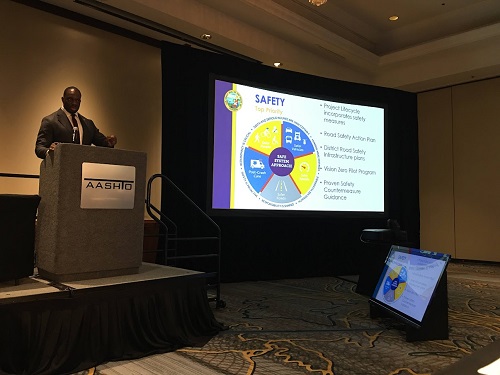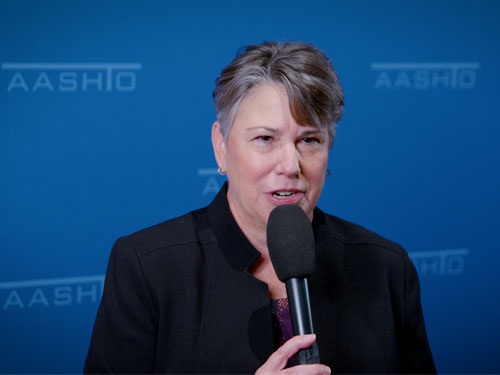The opening session of the 2023 Safety Summit hosted by the American Association of State Highway and Transportation Officials in Kansas City mapped out the “shared responsibility” among state departments of transportation, federal and local government agencies, private industry, and other stakeholders to improve safety for the movement of people and goods across the country.
[Above photo of Jim Tymon by AASHTO]
“The most important thing we work on, collectively and individually, is the safety of the traveling public when they use the nation’s transportation system,” noted Patrick McKenna, director of the Missouri Department of Transportation and former AASHTO president.
“We need to ask two basic questions: Are we doing enough? Are you doing enough? And we know that by looking at the evidence and the data that we are not. The devastation on our highways that ripples across families in this country shows we are not doing enough,” he said.
Recent data from the National Highway Traffic Safety Administration estimates that 19,515 people died in motor vehicle traffic crashes in the first half of 2023 – a decline of 3.3 percent compared to 20,190 fatalities in the first half of 2022, which means traffic fatalities have now declined for five straight quarters, even as vehicle miles traveled or VMT continues to increase.

Yet though fatality numbers are declining, they still remain far too high, noted Roger Millar, secretary of the Washington State Department of Transportation and AASHTO president.
“We are making some progress on [reducing fatalities] but nearly 40,000 deaths on our nation’s roadways is not zero,” he said. “We collectively invest billions to address congestion our highways; traffic congestion that has an economic impact of roughly $110 billion per year. Yet NHTSA says motor vehicle crashes cost the economy $1.4 trillion. This is yet one more reason why safety is our number one priority.”
While Millar stressed that state DOTs are “not shifting blame – we own a part of this” when it comes to reducing roadway fatalities, state DOTs are only a part of the solution.
“We have to reexamine how we use our transportation system,” he explained. “This will be disruptive – and we have to acknowledge that will create costs and inconvenience to motorists.”
Toks Omishakin, secretary of the California State Transportation Agency, added that while there are often many skeptics for the “Vision Zero” goal state DOTs are adopting to reduce roadway fatalities, he feels “strongly” that zero fatalities is not an unachievable goal.

“Many communities are seeing significant declines in fatalities, especially in the European Union,” he pointed out. “In 15 years, Europe went from 50,000 roadway fatalities to less than 21,000 using the ‘Safe System’ approach we are now adopting in the U.S. Let’s put that out front. Let that guide what we spend our resources on. For more and more should be spent on ensuring people have a safe way to travel.”
To that end, Russell McMurry – commissioner of the Georgia Department of Transportation – noted that state DOTs need to draw more heavily on data and design tools to make the nation’s transportation infrastructure safer from end to end.
“We are now faced with many challenges across transportation,” he said. “We need to work more on ensuring how the infrastructure we design, build, and maintain improves safety. We have many more tools and so much more data to make better decisions. It is incumbent upon us to educate our staff on what tools to use and how to use them.”
And developing a more collective and focused effort within the state DOT community and the transportation industry as a whole is the reason behind the Safety Summit, explained Jim Tymon, executive director of AASHTO.
“This is anchored in Roger Millar’s call for developing a resilient transportation system that is safe, sound, and smart,” Tymon said. “This summit aims to develop policy recommendations for AASHTO’s board of directors to consider at its annual meeting [in November] as well as develop a ‘safety action plan’ that will rely on a ‘whole of AASHTO’ approach to addressing the safety crisis.”
He noted that this effort is bringing together different committees and councils within AASHTO to help embed a more robust safety culture within state DOTs and lifecycle of the transportation projects they oversee as well.
“There should not just be one group of people addressing [transportation] safety issues,” Tymon stressed. “It should be the entirety of the state DOT community and of AASHTO as well.”
 Top Stories
Top Stories
USDOT Makes $1.5B Worth of BUILD Grants Available
December 19, 2025 Top Stories
Top Stories

